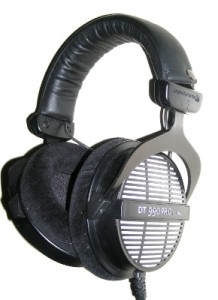DT990 Pro (250Ω)
back to Beyerdynamic
back to measurements
home
published: Feb-28-2015, updated: Apr-17-2022
NO SMOOTHING is applied to the shown plots. Most measurement sites have some smoothing applied which ‘irons flat’ sharp peaks and ‘wiggles’. I do not use smoothing because some info about sound quality is lost when plots are smoothed.
Aside from a small correction of the microphone itself also some correction in the lowest frequencies is applied to the plots to compensate for the perceived loss of bass when using headphones. This is described HERE in more detail.
A ‘horizontal‘ frequency response curve on the shown frequency response plots on this website thus indicates a perceived ‘flat’ tonal signature.
ALL measurements are made with a good SEAL on a flatbed measurement rig.
The shape of your head, bone structure, pad size, pad ‘softness, (compliance), hair or no hair and or wearing glasses may (drastically) change the frequency response of some headphones, so… your personal experience may differ substantially from these plots.
Frequency response (tonal balance) is the most sound-determining aspect of headphones. A horizontal line shows audible neutral response in the plots on this website. Deviations in different severities at different frequency bands have an effect on the sound character.
The bigger the deviation the stronger the effect.
Below an aid to help determining the sound character of headphones with relation to the frequency response.

Beyerdynamic DT990 Pro-250Ω
The DT990 Pro in 250Ω impedance is a well known headphone in the headphone community.
It is a rugged headphone intended to be used from amplifiers with a higher output voltage.
This one has black velours pads which measure closely the same as the grey DT990 pads.
These headphones are very comfortable and have a decent clamping force which is higher than the edition version.
The cups swivel in all directions and the sliding mechanism works problem free and has proven itself in this classic design.
It can be taken apart pretty easily and components can be replaced easily and support for obtaining spare parts is excellent.
The Beyerdynamic series DT770-DT880-DT990 exists in many different versions that have been released through their many, many years of existence.
These headphones are pretty lightweight, quite comfortable with soft padded headbands which are easily replaced as well as the velour pads The pads are a bit ‘squeaky’ when rubbing against (reading) glasses.
The cable for the Pro version is partly curled and sturdy. Not ideal when using it on the go but it is not intended for this anyway. The coiled cable is better suited for studio work.
Unfortunately the cable is non replaceable but is quite low in microphonics. It terminates in a 3.5mm TRS jack with a screw-on 6.3mm adapter.
Cable swappers need to modify the headphone when they want to change or shorten the cable or make it suitable to be driven by a balanced amplifier.
One of my DT990’s had a broken plug. 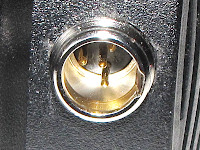 I took the opportunity to make the cable removable. A 4-pin mini XLR socket was installed. This, not only is far more convenient than a fixed cable but also allows different length cables to be used. This particular DT990 can now also be connected to balanced amps as well (when a balanced cable is used).
I took the opportunity to make the cable removable. A 4-pin mini XLR socket was installed. This, not only is far more convenient than a fixed cable but also allows different length cables to be used. This particular DT990 can now also be connected to balanced amps as well (when a balanced cable is used).
specifications:
Type: Over ear, open
Usage: Home
Driver type: dynamic
Pads: replaceable, velour
Inner Pad dimensions: depth = 20mm, ø 58mm
Collapsible: No
Headphone connector: none, fixed (non replaceable) cable.
Cable entry: single sided (left)
Cable: 3m terminated in 3.5mm TRS with screw-on 6.3mm adapter.
Driver size: ø 45mm
Nom. power rating: 0.1W (100mW)
Max. voltage: 5V
Max. current: 20mA
Max. S.P.L.: 115dB
Impedance: 250 Ω
Efficiency: 96dB @ 1mW
Sensitivity: 102dB @ 1V
Weight: 320 g. (with cable)
Colour options: Black
Clamping force: low (3.5N)
Accessories: Ø3.5mm to Ø6.3mm gold-plated connector, travel bag
Sound description:
The DT990 has a U-shaped character with a boomy and not well extended bass. Bass isn’t really ‘tight’.
The mids are warm and clarity is lacking compared to the DT880 versions. Those that find the DT880 a bit too clinical may well like the DT990 better.
The mids being relatively ‘sucked out’ which gives it a ‘musical’ and ‘forgiving’ nature on popular music and other not so well recorded studio material. Recordings that sounds ‘midrangy’ on flatter headphones and lack bass and treble will sound guite ‘full’ on these headphones.
Music that is recorded pretty well sounds overly bassy/fat and sharp/shrill/piercing though.
Jazz, classical as well as vocal or ‘hifi’ lovers may find this headphone too euphonic, as it lacks ‘realism’ but is ‘pleasant’ on most pop music.
The DT990 also lacks sub-bass but is more or less ‘masked’ by the overblown bass/lower mids.
Depending on music genre and taste, these headphones may be a good choice as they are relatively cheap and ‘forgiving’ and have a ‘fun’ sonic signature.
The treble is elevated but not poor quality/grainy. With popular music the elevated bass and treble could well be a blessing if one doesn’t mind the fierce treble. It works fine with classical music where the elevated treble gives the impression of a highly detailed sound.
With well made recordings the bass and treble are a fair bit too much.
measurements:
Below the frequency response of the DT990Pro (Left, Right):

This plot represents pretty well how it sounds. It is U-shaped and has lots of ‘warmth’ and is bassy. It also has a lot of treble energy up top.
Below a second DT990Pro -250 (Left, Right):
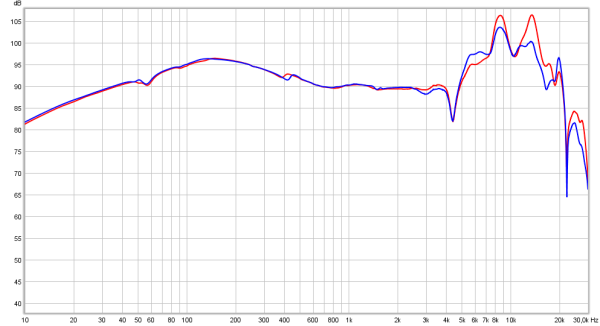
Good channel matching up to 5kHz. Above 5kHz the treble response differs from the older version and between left and right. Elevated mid-bass and substantially elevated treble.
comparison
Below the differences between the (old) DT990 – 600Ω and the current DT990Pro -250Ω version.
Both with slightly used but still fresh pads (left channel only).
The newer DT990 Pro obviously has almost 4dB more bass and appears to have even more ‘sucked out’ mids.
The older DT990 is more realistic and less ‘warm’ sounding, but still sounds somewhat ‘sucked out’.
The treble on both headphones is a bit too much and gives the headphone a (false) sense of ‘hyper detail’.
The highs, even though a bit piercing at times, sounds ‘smooth’. The DT990Pro is slightly ‘better’ in the treble but these differences are marginal.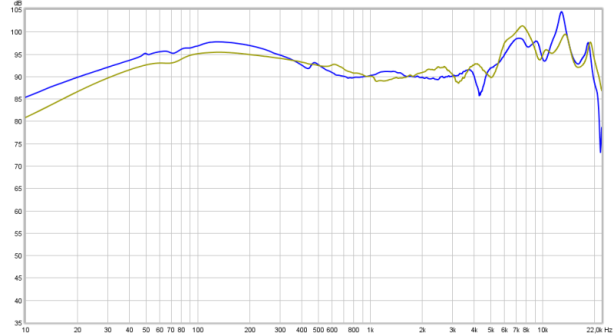
Below the DT990-250 vs the Amiron Home
The Amiron extends slightly deeper in the lows but also is a bit muddier in the mids. Upper mids (clarity) also is a bit lower. Both have elevated treble but peak at different frequencies.
Another comparison between the DT990-250 and the DT880 Black Edition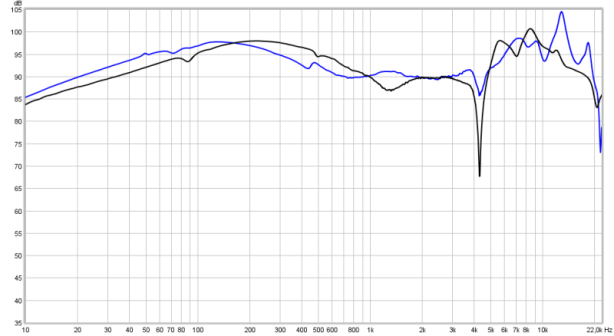
The DT880 Black Edition has less bass extension and sounds muddier in the bass. Both have elevated treble.
The DT990 is the better sounding one.
Below the DT880 (the regular version) vs the DT990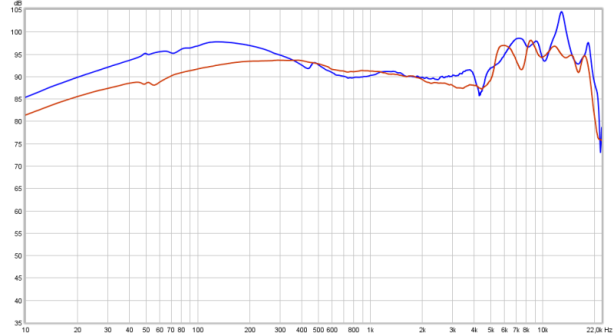
The DT880 has a lot less bass and is the more neutral one albeit a bit ‘thin’ sounding. The elevated treble makes the DT880 sound relatively sharper as well.
Below the closed version, the DT770 Pro vs the DT990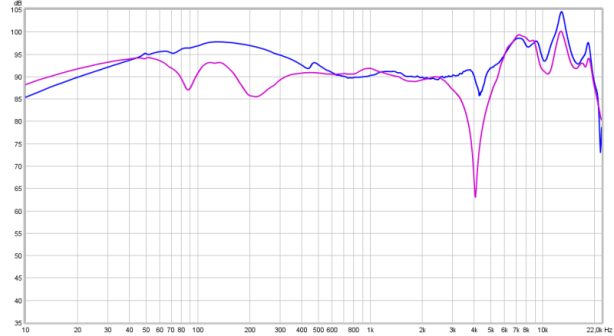
The DT770 has better bass extension but bass quality isn’t the best one. A bit dis-attached from the rest of the music. Mids are good bit also here the elevated treble.
The DT990 has a more expensive Tesla driver brother with replaceable cable, metal enclosure and comes with 2 different pads.
The A(nalytical) pads turn the DT1990 a DT880 alternative. Using the DT1990-B(alanced) pads it is an improved DT990.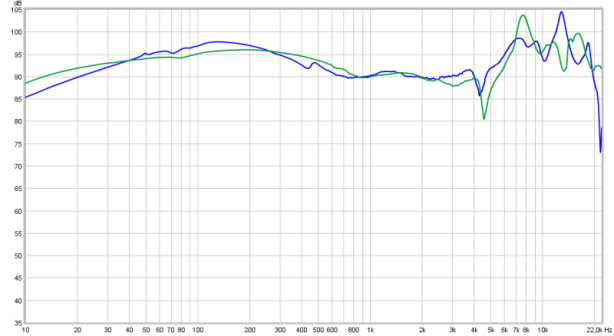
The DT1990 has better bass extension, less of a midbass hump so a bit clearer sounding but has an annoying treble peak (which is fixable)
Below the DT990 versus the Flagship T1 mkII

Similar bass extension, more ‘warmth’. There appears to be less clarity because of the recessed 1.5kHz to 4kHz area but this is not really as deep as it looks. The T1 driver is angled (for better imaging) and because it is angled the 1.5kHz – 4kHz area is elevated due to the shape of the pinnae. Of course there is the obligatory treble peak in the T1 as well only a little higher up in frequency.
Seal
Seal can be an issue with closed-back headphones. Much less so with open headphones. The DT990-Pro 250 is as good as immune against poor seal. Perfect seal, seal broken by thin armed glasses, seal broken by thick armed glasses, seal broken by slightly lifting the pads.
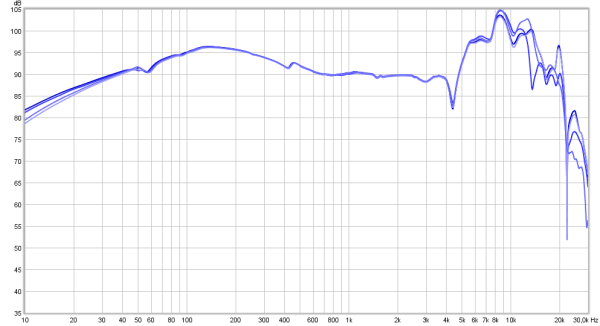
Phase response
Below the phase response of the DT990 (Left, Right)
Gentle sloping phase is not audible. Above 4kHz the phase changing within a narrow frequency band is more problematic and shows there are resonances in that area. Pad-bounce (65Hz) is minimal.
output resistance / damping-factor
As this is a dynamic headphone the frequency response can be amplifier output resistance dependent when certain higher output resistance amplifiers are used.
Instead of showing impedance plots, which are hard to ‘read’ when it comes to assessing the tonal balance change in the real world, the DT990 is measured via a 4 different output resistances (0.2Ω, 10Ω, 32Ω and 120Ω). On a higher output resistance amplifier the output level will be lower of course due to voltage division. To compensate for this the amplifier is cranked up to the same level (3.5dB for 120Ω at 1kHz in this case). This way the plots are overlaid and it is easier to see how the tonal balance changes. Output resistances between the mentioned resistance values will result in tonal changes between those traces.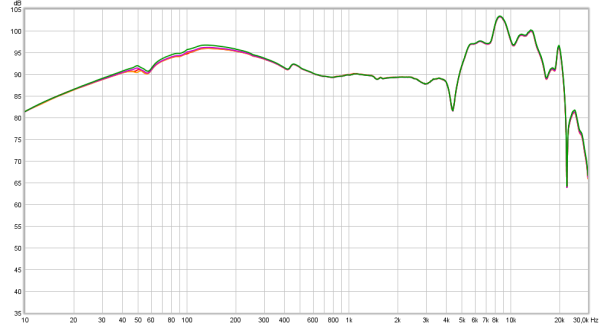
The tonal balance hardly changes when the DT990 is connected to a higher output resistance amplifier.
Below the distortion measurements of the DT990 (Left channel).
The plot above shows the level differences between the signal (upper trace around 90dB SPL) and the harmonics. Most people prefer to see percentages instead of level differences so below the exact same plot except ‘normalized’ to the actual signal and level differences given in percentages.
 Distortion levels in the lowest frequencies are mainly 2nd harmonic above 100Hz distortion drops below 0.5% which is good for a driver of this size.
Distortion levels in the lowest frequencies are mainly 2nd harmonic above 100Hz distortion drops below 0.5% which is good for a driver of this size.
The actual 2nd harmonic distortion above 1kHz may well be lower than 0.2% . A shortcoming of my measurement rig.
Below the CSD (waterfall) plot of the DT990 . (Left and Right are overlaid)
The narrow dip at 4kHz is a resonance in disguise. Above 4kHz some resonances but all very short lived and well damped.
Below the Group Delay plot for the DT990 (Left, Right)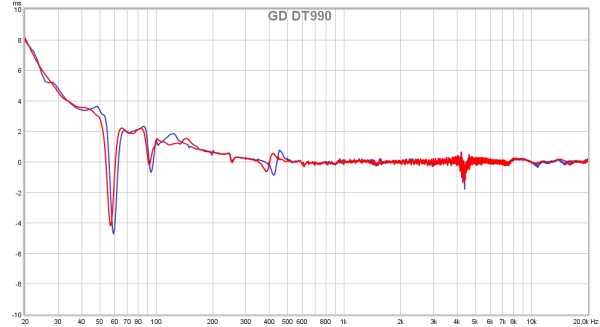
There is some pad bounce at 60Hz and 90Hz, otherwise no surprises here. At 450Hz there is a resonance as well as at 4.5kHz. It is also seen in the frequency response plot.
A different plot is the spectrum plot. This basically is a CSD (Waterfall) plot but viewed from above where the level differences are colour coded instead of being in the vertical axis. Also the frequency range of the spectrum plot is wider (from 100Hz instead of 500Hz). The time span is also bigger in the spectrum plots and expired time is shown from below to top where in the CSD the time is shown from rear to front.
Below the spectrum plot of the DT990 (Right channel)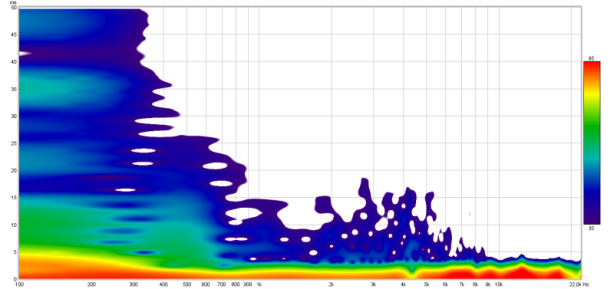
No alarming issues here either. Some lingering around 450Hz (also seen in the plots above)
Step response
Below the step response plot which, when the sound is balanced and well extended should show a rise to around 0dB, (indicating fast driver response) and should be slightly sloping downwards indicating bass extension. (Left, Right)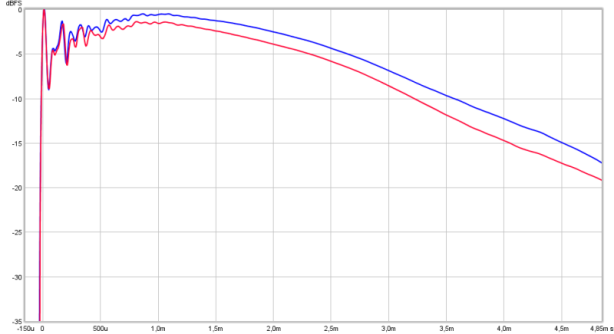
The lack of deep bass extension is visible as the horizontal trace drops after 1.5ms. The fast rise and lower level of the mids are indicative for the peaky treble.
pads
Below, alternating, the DT990 Pro fitted with new (EDT990V) pads (24mm height) v.s. some lightly used pads (21mm), well used pads (18mm), cheap -ebay replacement pads, DT880 Black Special Edition pads and (black) EDT990VB pads.
The grey EDT990V pads and black EDT990VB pads are performing the same. The black DT880BSE pads may appear to be the same on the outside but are not the same pads. When pads are worn the treble is affected a bit.
reducing the treble
The DT 700 PRO X model, just like the DT 900 PRO X, TYGR, T1mk3, T5mk3 and Amiron Wireless all have substantially different looking anti-dust discs in front of their drivers compared to the foam discs in earlier models that all have substantial treble peaks.
The center part of these fleece discs (over the driver) is thicker and reduces the treble.
The effect of this material in front of the TYGR is shown in the evaluation of it.
In the TYGR 300 R (below on the left) a different disc is used from the one of of the DT 700 PRO X (on the right).
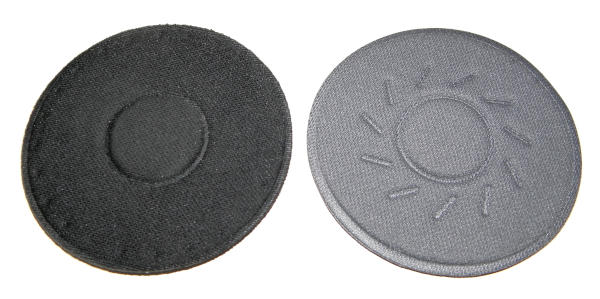
How effective will these fleece discs be in reducing the Beyer treble peaks of the DT990Pro ?
Below the stock DT 990 Pro/250 versus the DT990 Pro fitted with the DT 700 PRO X fleece disc and compared to 1- and 2-plies of 2-ply toilet paper and the passive filter described further down below.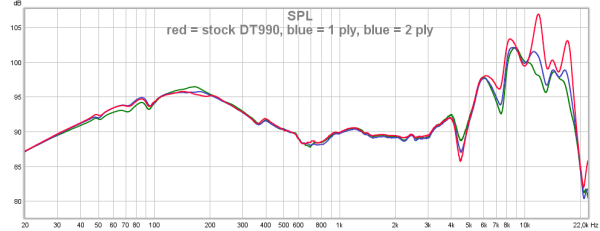
The long held dream of many DT770/880/990/1990/T1 etc. owners to tame the treble peaks of their headphones without resorting to modifications, EQ or filtering by simply replacing the regular foam disc with a fleece disc from a DT700 or DT900 can be answered by… keep dreaming.
The fleece disc is no more effective than 2 single sheet of 2-ply toilet paper tucked underneath the foam disc. So a slight reduction but not enough.
This fleece disc is specifically designed to lower the treble from this new driver to the level as intended by the Beyerdynamic designer(s) and these newer drivers have much less upper treble than the older drivers.
passive filter
A more ‘targeted’ lowering of the treble peak can be done using a passive filter. Below the schematic for the DT990-250 filter (not suited for other impedances)
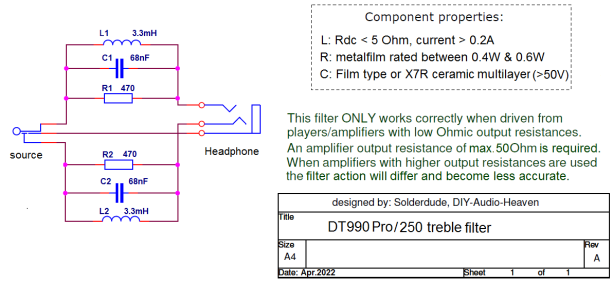
Below the stock DT990Pro-250 and using the treble filter described above.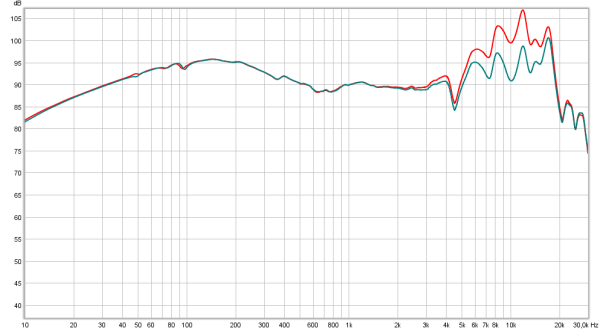 There still is some excess upper treble energy which can be lowered using a single ply That upper treble range usually can de addressed by covering the middle part of the driver with a single ply. So not a sheet of a 2- or 3-ply toilet paper but the individual layers pulled apart after they have been cut to the desired shape. The middle part must only cover the middle area and not the paper part around the driver.
There still is some excess upper treble energy which can be lowered using a single ply That upper treble range usually can de addressed by covering the middle part of the driver with a single ply. So not a sheet of a 2- or 3-ply toilet paper but the individual layers pulled apart after they have been cut to the desired shape. The middle part must only cover the middle area and not the paper part around the driver.
Below an idea how to do this without covering the paper damper around the driver.
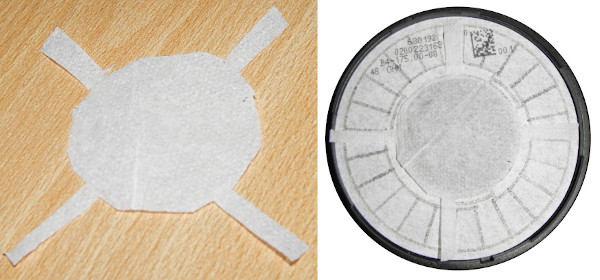 The effect is subtle but as it is over a wider range it is still a small improvement.
The effect is subtle but as it is over a wider range it is still a small improvement.
Below a comparison between the stock DT990 and with 1 ply of toilet paper + treble filter
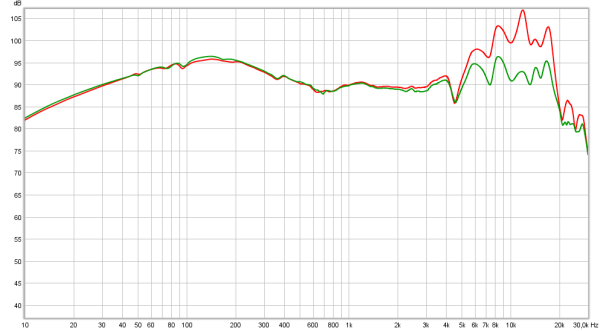 The treble peak is completely removed and the treble is now at the correct level and of much higher quality as well.
The treble peak is completely removed and the treble is now at the correct level and of much higher quality as well.
As a fun project the DT990 below has been modified with a filter (shown above), has new headband padding, black EDT990VB pads and foam discs and has been fitted with a 4-pin mini XLR socket so it can even be used with a balanced amplifier (if needed).
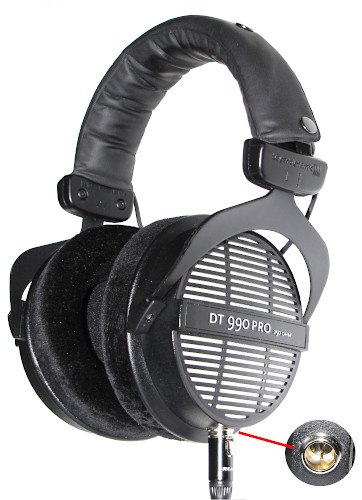
One can also use (parametric) EQ or use the Kameleon.
Of course the DT990Pro/250 can also be corrected with the Kameleon amplifier which can also address the elevated low bass and extend the subbass.
Below the difference between the stock DT990Pro-250Ω and via the Kameleon amplifier.
Bass extension is formidable and below 10Hz, the bass hump has been removed which ‘tightens’ the bass.
I gave it a bit of extra ‘bass’ because the headphone is open and DT990 owners do prefer ‘strong’ bass. The elevated treble peak has also been lowered.
As both the bass and treble peaks have been removed the mid-range isn’t recessed any more. Treble extension, clarity are excellent.
Below the frequency response (L and R) of the DT990Pro-250Ω on the kameleon.
conclusion
The Beyerdynamic DT990-Pro 250 is a sturdy workhorse often found in studios (along with the closed DT770).
It is very comfortable, highly affordable with available parts like the headband padding and pads.
The long curled cable is handy in studios where one does not want to stand on or trip over long cables.
The clamping force for the pro versions is kind of high.
Those looking for different looks, less clamping force are better off with the Edition versions or the Manufaktur (you can choose a color scheme). Those wanting to connect one to portable gear should buy the 32Ω version instead or look into the DT900Pro X.
The DT990-250 and certainly the 600Ω version require a decent amplifier.
It is not a neutral headphone and has no thunderous bass either but it has a warm and detailed sound. The treble peak does not seem to bother everyone. Those that do should address this via EQ or a filter or reducing treble with toilet paper or felt.

